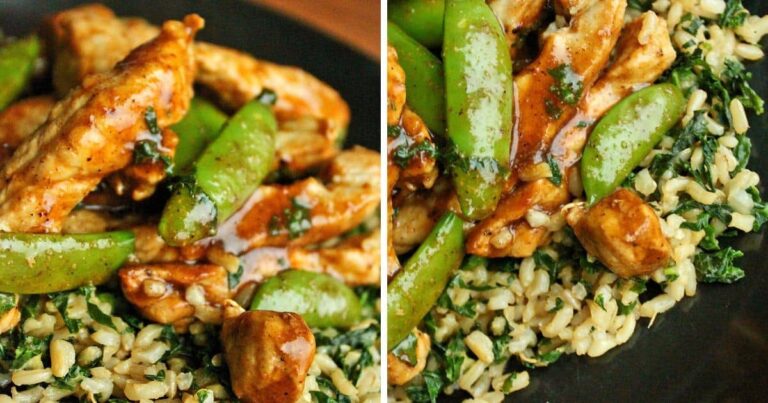This recipe for Ginger Pork with Sugar Snap Peas is a tasty stir-fry that can be prepared quickly and tastes great for a midweek supper.
Ingredients
- 1 lb (450g) pork tenderloin, thinly sliced
- 2 tablespoons soy sauce
- 1 tablespoon rice vinegar
- 1 tablespoon cornstarch
- 2 tablespoons vegetable oil (divided)
- 2 cups sugar snap peas, trimmed
- 1 red bell pepper, thinly sliced
- 3-4 green onions, chopped
- 2-3 cloves garlic, minced
- 1 tablespoon fresh ginger, grated or finely minced
- 1 tablespoon soy sauce
- 1 tablespoon oyster sauce
- 1 teaspoon sesame oil
- 1 teaspoon honey or brown sugar (optional)
- Cooked rice, for serving
How to prepare your ginger pork with sugar snap peas
- Marinate the Pork (Prepare the Pork, Make the Marinade)
- Cook the Vegetables (Heat the Oil, Cook the Vegetables)
- Cook the Pork (Stir-Fry the Pork)
- Combine and Finish (Add Aromatics, Add Sauces, Adjust Seasoning)
- Serve (Plate the Dish, Garnish)
Cut the pork tenderloin thinly, going against the grain. Combine the pork with the scallion whites, half the ginger, half the garlic, all the sugar, all the soy sauce, all the cornstarch, all the sherry, and all the sesame oil in a bowl. Soak for approximately fifteen minutes at room temperature.
Reserve the remaining 1 tbsp cornstarch mixture made with 2 Tbsp water. Heat one tablespoon of vegetable oil in a big skillet or wok over medium-high heat. Add the red bell pepper and sugar snap peas. Stir-fry for two to three minutes, or until crisp-tender. After taking the veggies out of the skillet, set them aside.
Over high heat, preheat a large skillet or wok. Heat after adding 1 T. of the peanut oil.
Stir-fry the sugar snap peas with the remaining garlic and ginger for approximately a minute, or until they turn brilliant green but remain crisp. Transfer to a sizable bowl and season with salt and pepper to taste. Add two more T. oil and reheat the empty skillet over high heat.
Stir-fry half of the pork mixture for about two minutes, or until it is lightly browned. Season with salt and pepper to taste. Toss the cooked pork from the first batch with the bowl of sugar snap peas. Continue with the remaining pork and oil.
Add the hoisin and the cornstarch/water combination to the skillet along with all of the pork and sugar snap peas. Cook for approximately a minute, or until the juices thicken. Scatter the scallion greens on top of the stir-fry and pile it onto a serving platter or divide it among four plates.
Toss in the grated ginger and minced garlic with the pork. Stir-fry until aromatic, about 1 more minute. After cooking, add the veggies back to the skillet. Stir in the sesame oil, oyster sauce, soy sauce, and brown sugar, if using.
After tossing everything together, cook for a further one to two minutes, or until heated through and thoroughly blended. If necessary, taste and adjust the seasoning.
Overcooked rice, serve the ginger pork and sugar snap peas and you might choose to add more chopped green onions or sesame seeds as a garnish.
DIY: Make Ginger Pork With Sugar Snap Peas FAQs
Are sugar snap peas better raw or cooked?
The best ways to eat snap peas are raw or very short cooked, including in stir-fries or rapid sautes. Snap peas can be steamed or blanched and then seasoned with salt, pepper, and a little butter for an easy side dish. The majority of sugar snap peas require the stringy seams to be removed before consumption, despite the existence of stringless variants.
Do you cut sugar snap peas before cooking?
There are two main uses for sugar snap peas when chopped: to improve their eating convenience and aesthetic appeal. to guarantee even cooking when included into salads, stir-fries, and other dishes.
What is the best way to eat sugar snap peas?
To preserve their delicious crisp crunch, consume sugar snap peas fresh or cooked only until tender. They go well in salads and stir-fries.
How to tell when sugar snap peas are bad?
A prominent sign that a snap pea is not fresh is discoloration; yellow or almost yellow snap peas are not as fresh as their green counterparts, while black, brown, and mushy snap peas are unfit for consumption. Another obvious indication that the snap pea has gone bad is mold.
Source: www.Ghgossip.com


Comments are closed.